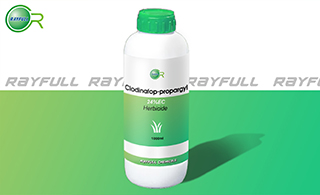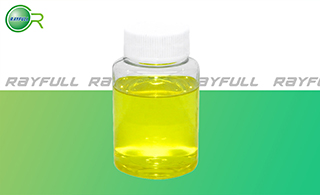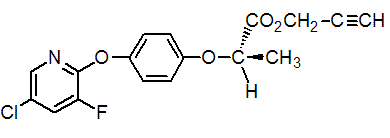CLODINAFOP-PROPARGYL
  ИІІЭхҘ ИІІЭхҘ
Introduction: A herbicide for annual grass weed control in a range of crops, such as Cereals including wheat, triticale and rye.
Common name: Clodinafop-propargyl
Another name: Topik, Discover, Discover Herbicide, Clodinafop-proargyl, Discover Herbicide, clodinafop propargyl ester, etc.
Chemical name: prop-2-ynyl (R)-2-[4-(5-chloro-3-fluoro-2-pyridyloxy)phenoxy]propionate
Empirical formula: C17H13ClFNO4
Structural formula:

Mol. Weight: 349.8 g/mol
CAS No.: 105512-06-9
Specifications
Leading Clodinafop-propargyl supplier
Clodinafop-propargyl 240 g/L EC
Clodinafop-propargyl 95% TC
Packing:
BULK PACKING
Solid: 25kg/Bag, 25kg/Drum, 50kg/Drum etc.
Liquid: 200L/Drum, 20L/Drum, 10L/Drum ect.
SMALL PACKING
Solid: 1kg/Alu bag, 500g/Alu bag, 200g/Alu bag, 100g/Alu bag, 50g/Alu bag, 15g/Alu bag etc.
Liquid: 5L/Drum, 1L/Bottle, 500ml/Bottle, 250ml/Bottle, 100ml/Bottle, 50ml/Bottle etc.
Customerized packing label
Clodinafop-propargyl FAO standard
Professional registration
HAZARDS IDENTIFICATION
Hazard statement(s)
H302: Harmful if swallowed.
H317: May cause an allergic skin reaction.
H373: Causes damage to organs through prolonged or repeated exposure.
H410: Very toxic to aquatic life with long lasting effects.
Precautionary statement(s)
P260: Do not breathe dust/fume/gas/mist/vapors/spray.
P261: Avoid breathing dust/fume/gas/mist/vapors/spray.
P264: Wash ... thoroughly after handling.
P270: Do not eat, drink or smoke when using this product.
P272: Contaminated work clothing should not be allowed out of the workplace.
P273: Avoid release to the environment.
P280: Wear protective gloves/protective clothing/eye protection/face protection.
P301+P312: IF SWALLOWED: call a POISON CENTER/doctor/... IF you feel unwell.
P302+P352: IF ON SKIN: wash with plenty of water.
P314: Get medical advice/attention if you feel unwell.
P321: Specific treatment (see ... on this label).
P330: Rinse mouth.
P333+P313: IF SKIN irritation or rash occurs: Get medical advice/attention.
P363: Wash contaminated clothing before reuse.
P391: Collect spillage.
P501: Dispose of contents/container to ...
Supplemental Hazard Statements: none
MAMMALIAN TOXICOLOGY
Acute toxicity: 1) Acute oral LD50 for rat: 1392 a.i.mg/kg. 2) Acute dermal LD50 for rat: >2000 a.i.mg/kg. 3) Inhalation LC50 (4 h) for rat: >2.32 a.i. mg/L. 4) Non-irritating to skin (rabbit). 5) Non-irritating to eye (rabbits). 6) May cause skin sensitisation (guinea pigs).
NOEL: (2 y) for rats is 0.35, (18 mo) for mice is1.2, (1 y) for dogs is 3.3 mg/kg b.w. daily.
ADI: 0.003 mg/kg b.w./day [Rat, SF=100]
Classification:
US EPA Classification (formulation): No consensus across products
EC Risk Classification: Xn - Harmful: R22, R43, R48/22; N - Dangerous for the environment: R50, R53
ECOTOXICOLOGY
Effect on birds: moderate toxicity to birds, acute oral LD50 for Bobwhite quail is 1363 a.i.mg/kg. Effect on fish: moderate toxicity to fish, acute 96 hour LC50 for Bluegill sunfish is 0.21 a.i.mg/L. Effect on aquatic invertebrates: moderate toxicity to aquatic invertebrates, acute 48 hour EC50 for Crassostrea virginica is 0.77 a.i.mg/L. Effect on algae: moderate toxicity to algae, acute 72 hour EC50 for Scenedemus subspicatus is >1.6 a.i.mg/L. Effect on honeybees: moderate toxicity to honeybees, contact acute 48 hour LD50 is 40.9 a.i.ҰМg/bee; oral acute 48 hour LD50 is >93.7 a.i.ҰМg/bee. Effect on earthworms: moderate toxicity to earthworms, acute 14 day LC50 for Eisenia foetida is 197 a.i.mg/kg.
ENVIRONMENTAL FATE
Clodinafop-propargyl's production may result in its release to the environment through various waste streams; its use as a herbicide will result in its direct release to the environment. If released to air, a vapor pressure of 2.4ЎБ10-8 mm Hg at 25 deg C indicates clodinafop-propargyl will exist in both the vapor and particulate phases in the atmosphere. Vapor-phase clodinafop-propargyl will be degraded in the atmosphere by reaction with photochemically-produced hydroxyl radicals; the half-life for this reaction in air is estimated to be 5 hours. Particulate-phase clodinafop-propargyl will be removed from the atmosphere by wet or dry deposition. Clodinafop-propargyl does not contain chromophores that absorb at wavelengths >290 nm, and therefore is not expected to be susceptible to direct photolysis by sunlight. If released to soil, clodinafop-propargyl is expected to have slight mobility based upon an estimated Koc of 2,000. Volatilization from moist soil surfaces is not expected to be an important fate process based upon an estimated Henry's Law constant of 2.8ЎБ10-9 atm-cu m/mole. Clodinafop-propargyl may not volatilize from dry soil surfaces based upon its vapor pressure. A biodegradation half-life in soil of 0.5 to 1.5 days suggests that biodegradation may be an important environmental fate process in soil and water. If released into water, clodinafop-propargyl is expected to adsorb to suspended solids and sediment based upon the estimated Koc. Volatilization from water surfaces is not expected to be an important fate process based upon this compound's estimated Henry's Law constant. An estimated BCF of 170 suggests the potential for bioconcentration in aquatic organisms is high, provided the compound is not metabolized by the organism. The hydrolysis half-lives are 184 days at pH 5, 2.7 days at pH 7, and 2.2 hours at pH 9; therefore, hydrolysis will be an important environmental fate process under alkaline conditions. Occupational exposure to clodinafop-propargyl may occur through inhalation and dermal contact with this compound at workplaces where clodinafop-propargyl is produced or used. (SRC)
Usage: Reported by J. Amrein et al. (Proc. Br. Crop Prot. Conf. - Weeds,1989, 1, 71-76). Introduced by Ciba-Geigy AG (now Syngenta AG) and first marketed in 1990. Manufacturers: Syngenta. Fatty acid synthesis inhibitor, by inhibition of acetyl CoA carboxylase (ACCase).
Application: Post-emergence, systemic grass herbicide. Phytotoxic symptoms appear within 1-3 weeks, affecting meristematic tissue. Used for post-emergence control of annual grasses, including Avena, Lolium, Setaria, Phalaris and Alopecurus, in cereals, at 30-60 g/ha. Phytotoxicity Low toxicity to spring and winter wheat. Mainly used in combination with the safener cloquintocet-mexyl.
| 






